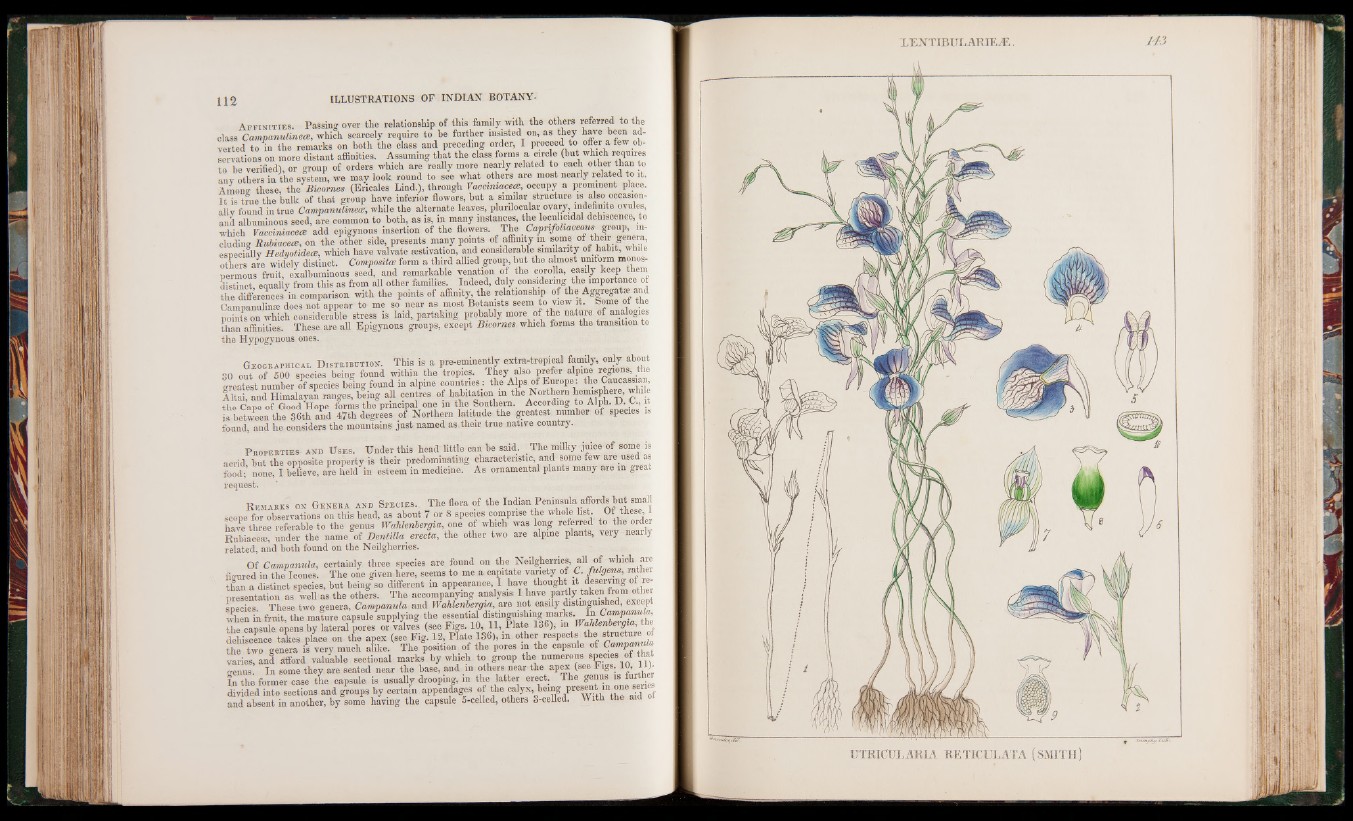
Affinities. Passing over the relationship of this family with the others referred to the
class Campanulinece, which scarcely require to be further insisted on, as they have been adverted
to m the remarks on both the class and preceding order, I proceed to offer a few observations
on more distant affinities. Assuming that the class, forms a circle (but which requires
to be verified), or group of orders which are really more nearly related to each other than to
anv others in the system, we may look round to see what others are most nearly related to it.
Among these, th»Bicornes (Ericales Lind.), through Vacciniacece, occupy a prominent place.
I t is true the bulk of that group have inferior flowers, but a similar structure is also occasionally
found in true Campanulinece, while the alternate leaves, plurilocular ovary, indefinite ovules,
and albuminous seed, are common to both, as is, in many instances, the M U M dehiscence, to
which VacciniacecB add epigynous insertion of the flowers. The Capnfohaceous group, including
Rubiacece, on the other side, presents many points of affinity m some of their genera,
especially IJedyotidece, which have valvate aestivation, and considerable similarity of habit, while
others are widely distinct. Composites form a third allied group, but the almost uniform monos-
permous fruit, exalbuminous seed, and remarkable venation of the corolla, easily keep them
distinct, equally from this as from all other families. Indeed, duly considering the importance of
the differences in comparison with the points of affinity, the relationship of the Aggregates and
Campanulime does not appear to me so near as most Botanists seem to view it. Some of the
points on which considerable stress is laid, partaking probably more of the nature of analogies
than affinities. These, are all Epigynous groups, except Bicornes which forms the transition to
the Hypogynous ones.
Geographical D istribution. This is a pre-eminently extra-tropical family, only about
30 out of 500 species being found within the tropics. They also prefer alpine reg.ons, tlie
greatest number of species being found in alpme countries: the Alps of Europe, the Caucassian,
llta i, and Himalayan ranges, being all centres, of habitation in the Northern hemisphere, while
the Cape of Good Hope forms the principal one in the Southern. According to Alph. D. C., it
is between the 36th and 47th degrees of Northern latitude the-greatest number, of species is
found, and he considers the mountains just named as,their true native country.
P roperties- and U ses. Under this head little can be said. The milky juice of some,is
acrid, but the opposite property is their predominating characteristic, and some few are used as
food; none, I believe, are held in esteem in medicine. As ornamental plants many are in great
request.
R emarks on Genera and Species. The flora of the Indian Peninsulaaffords but small
scope for observations on this head, as about 7 or 8 specites comprise the whole list Of these, 1
have three referable to the genus Wahleribergia, one of which was long referred to the order
Rubiaceae, under the name of Dentilla erecta, the other two are alpme plants, very nearly
related, and both found on the Neilgherries.
Of Campanula, certainly three species are found on the Neilgherries, all of which are
figured in the leones. The one given here, seems to me a capitate variety of C. fulgens, rathe
th£n a distinct species, but being so different in appearance, I have thought it Reserving ,of representation
as well as the others. The accompanying analysis I have partly taken from other
species. These two genera, Campanula and WaUenbergia, are not easily distinguished, except
when in fruit, the mature capsule supplying the essential distinguishing marks. In Campanula,
The capsule opens by lateral pores orv/lves (see Figs. 10, 11, Plate 136), m Wahlenbergca, ibe
dehiscence takes place on the apex (see Fig. 12, Plate 136), m, other respects the structure of
the two genera is very much alike. The position of the pores m the capsule of Campanula
varies, and afford valuable sectional marks by which to group the numerous species of that
genus. In some they are seated near the base, and m others near the apex (see ligs. 10, ilj.
fn the former case the capsule is usually drooping, in the latter erect. The genus is further
divided into sections and groups by certain appendages of the calyx, being presen
and absent in another, by some having the capsule 5-celled, others 3-celled. With the
W ÊÊÊÊKÊÊÊÊÊÊKÈÊÊÈ